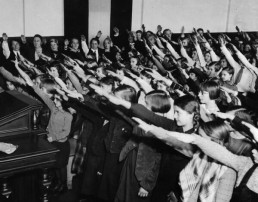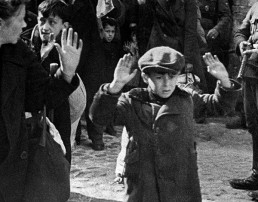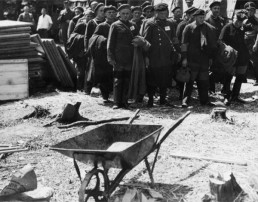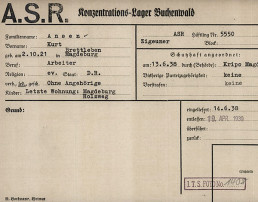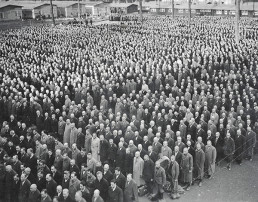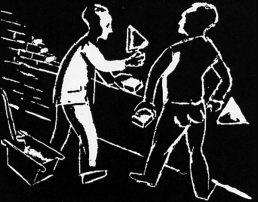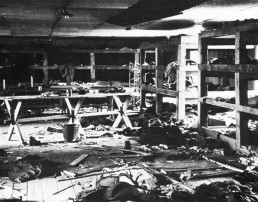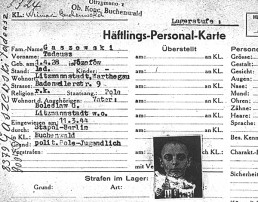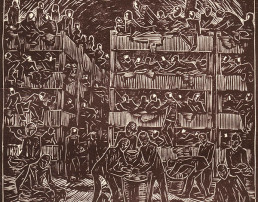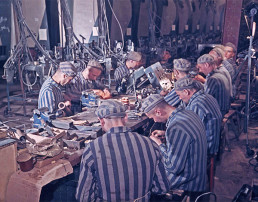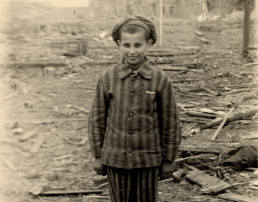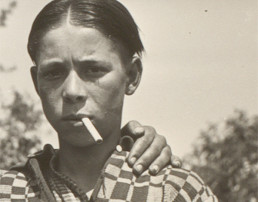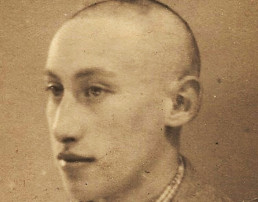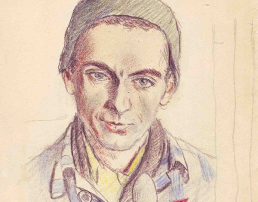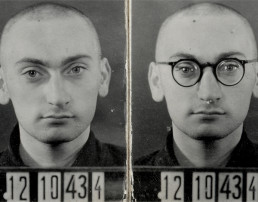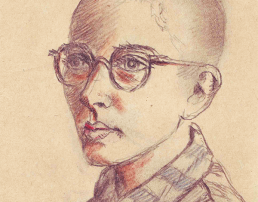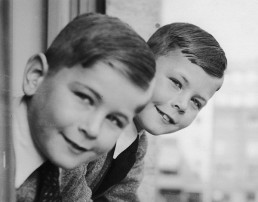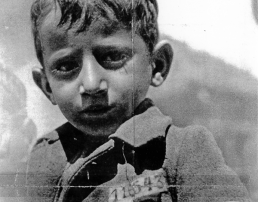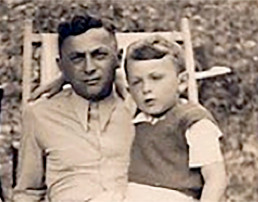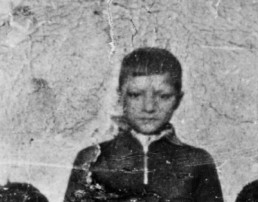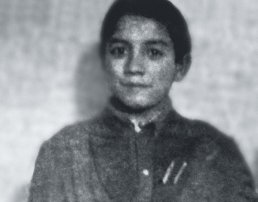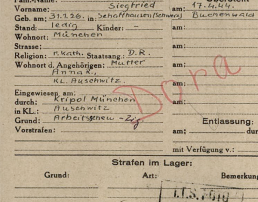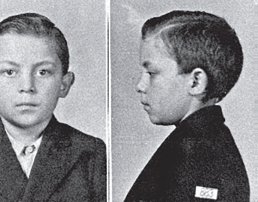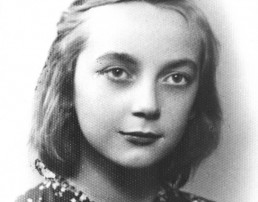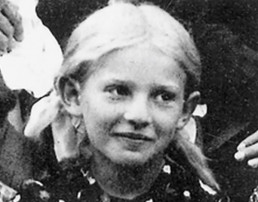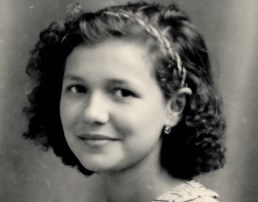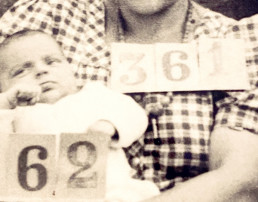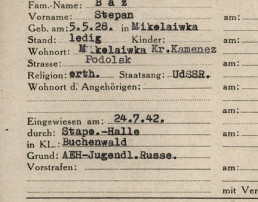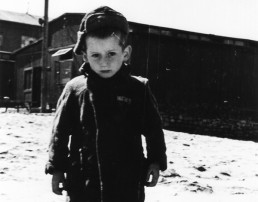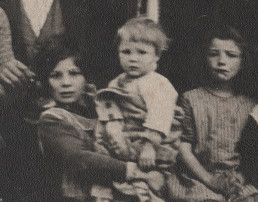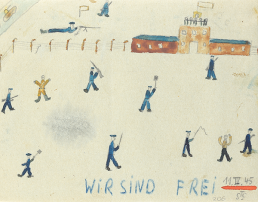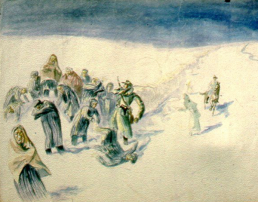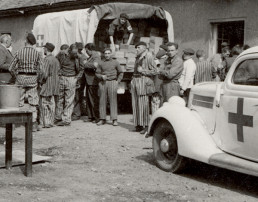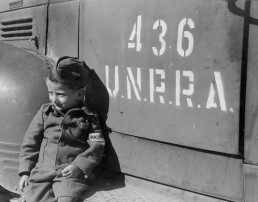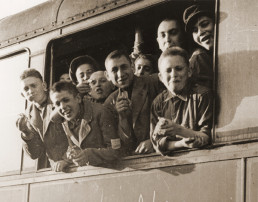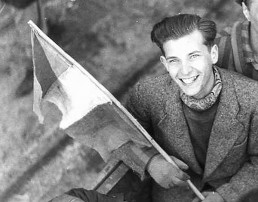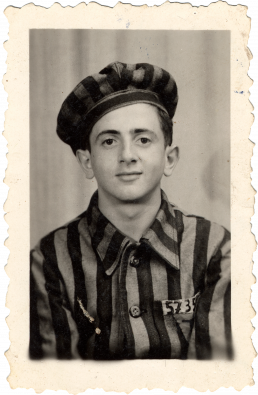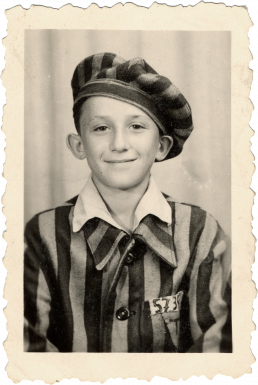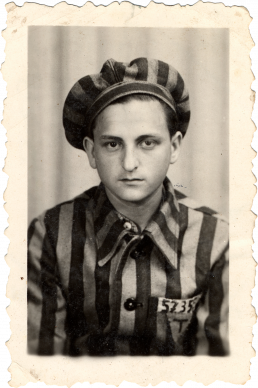
KURT ANSIN
A Sinto from Magdeburg

ERICH DAVIDSOHN
As a young “special operation Jew” in Buchenwald

EDOUARD TROUPENAT
A resistance fighter deported to Buchenwald

ROLF KRALOVITZ
As a Hungarian Jew from Leipzig to Buchenwald

JEAN LOUIS NETTER
A Jewish schoolboy in the Holzen subcamp

NAFTALI FÜRST
Deported from Bratislava with his brother

JOSEPH SCHLEIFSTEIN
(GEB. SZLAJFAZTAJN)
A three-year-old in Buchenwald

SHRAGA MILSTEIN
(GEB. FELIKS MILSZTAJN)
From Poland to Buchenwald and Bergen-Belsen

JAKOB GERSTE
From Nordhausen to Auschwitz and back again

FRANZ ROSENBACH
From Vienna via Auschwitz to Mittelbau-Dora

SIEGFRIED REINHARDT
The erasure of an entire family

EGON PETERMANN
Registered as a “Gypsy”, murdered in Auschwitz

MARIA JANINA KOSK
(GEB. BRZĘCKA)
Drawing and survival in the Meuselwitz subcamp

SUZANNE ORTS (NÉE PIC)
As a teenager in the Résistance

ZAHAVA SZÁSZ STESSEL
(NÉE KATALIN SZÁSZ)
A Hungarian Jew in the Markleeberg subcamp

ESTARE WEISER (NÉE KURZ)
Born in the concentration camp

STEPAN BAZ
Labor re-education prisoner in Buchenwald

STEFAN JERZY ZWEIG
The famous Buchenwald child
Several hundred children and well over ten thousand young people under the age of 21 were deported to the concentration camps Buchenwald and Mittelbau-Dora between 1937 and 1945. Thousands of them died. The online exhibition Children in Concentration Camps is dedicated to their fate. It follows the routes over which the children and young people were deported, recounts the reasons they were imprisoned, and examines the conditions of their existence: What specific experiences did children and young people have in the camps, what distinguished them from the experiences of adults? What happened to the survivors after liberation? What role do the Child Survivors of Buchenwald and Mittelbau-Dora play in public memory?
Herrenkinder and Outcasts: Childhood in the National Socialist Era
The Nazi state’s racist social order treated children and young people no differently than adults. The children of Volksgenossen (ethnic Germans) grew up believing that they belonged to a superior Herrenrasse (master race). Children of Jews, Sinti and Roma, of parents who were ill, considered asocial, and dissidents were excluded and persecuted. Many of them were murdered during the Second World War.
Integration into the Volksgemeinschaft
Nazi propaganda persuaded the children of the Volksgenossen that they were part of a superior Volksgemeinschaft (national community), giving them the feeling that they belonged to a…
Excluded – Persecuted – Murdered
Children of Gemeinschaftsfremden (lit.: strangers to the community, those people who were not considered to be part of the Volksgemeinschaft) were marginalized and persecuted in the Nazi…
Children in the Buchenwald Concentration Camp
From July 1937 to April 1945, approximately 266,000 people from countries all over Europe were imprisoned in Buchenwald Concentration Camp, including numerous children and young people. The minors were sometimes deported to Buchenwald with their parents, but generally they were alone. Political prisoners organized rescue initiatives to protect them and improve their chances of survival.
Aktion Arbeitsscheu Reich 1938
In 1938, the number of prisoners in the concentration camps doubled. As part of the Aktion Arbeitsscheu Reich (Operation Work-Shy Reich, two waves of arrests of purported “anti-social elements”),
1938: Deported to Buchenwald as “special operation Jews”
In the course of the November pogroms of 1938, the Gestapo sent 30,000 Jews, designated by the SS as “special operation Jews,” to concentration camps.
Rescue Initiatives: Bricklayers’ school and Poles’ school
Under the pretext of training skilled workers for the German war effort, prisoner functionaries around Robert Siewert, a political prisoner and Kapo of the construction detail
Limited shelter: The children’s blocks 8 and 66
Children were particularly vulnerable to the dangers of the camp. To protect them, political prisoner functionaries set up a children's block in Block 8 of the main camp in July 1943.
Deterrence through forced labor: Disciplinary work prisoners
From 1941 to 1944, a Gestapo labor re-education camp existed at the Buchenwald Concentration Camp.
Children in the Mittelbau-Dora Concentration Camp
In August 1943, the first prisoners from the Buchenwald Concentration Camp arrived at the Dora subcamp near Nordhausen where they worked as forced laborers building a rocket plant in a tunnel system. From the spring of 1944 onwards, the SS used prisoners for other construction projects in numerous subcamps in the region. The chances of survival were slim, especially for the children and teenagers used as forced laborers.
Trapped underground:
The tunnel expansion
The first transports to leave Buchenwald for Mittelbau-Dora in the fall of 1943 included several young people. Almost all of them were political prisoners.
From rocket plant to construction company: The Mittelbau-Dora Concentration Camp
After a British air raid on the Peenemünde Army Station, the Ministry of Armaments ...
Transferred from Auschwitz to the Harz Mountains: Jewish, Sinti and Roma children
The evacuation of the "gypsy family camp" in Auschwitz-Birkenau began in April 1944.
Hauled off to Concentration Camps
The biographies of children and young people under the age of 21 who were deported to the Buchenwald and Mittelbau-Dora Concentration Camps and their numerous subcamps show the diversity of the victim groups among the minors: Jews, Sinti and Roma, political prisoners deported from occupied territories, girls in subcamps, those deemed to be anti-social, and labor re-education prisoners.
Deaths in Buchenwald or Mittelbau-Dora
Thousands of children and young people died in the Buchenwald and Mittelbau-Dora Concentration Camps. Because many records are missing, not all names are known. For many of the dead, there is very little information available other than their names, prison numbers and dates of death. Photos exist only in a few cases.

Marek
Krzepicki
born in Poland
died 1945 in Ellrich-Juliushütte
persecuted for political reasons
aged 15


born in Hungary
died 1945 in Blankenhain
persecuted as a Jew
aged 18
Herman
Abraham

born in Poland
persecuted as a Jew
died 1945 in Buchenwald
aged 9
Maurycy Grosberg

born in France
persecuted for political reasons
died 1945 in Ellrich-Juliushütte
aged 16
Michel
Stègre


Name
unknown
died in Buchenwald

born in Hungary
persecuted as a Jew
died 1945 in Buchenwald
aged 15
Zsigmond
Fekete

Ruwald
Schwarz
born in Germany
persecuted as a Sinto
died 1945 in Ellrich-Juliushütte
aged 16

Attilio
Pozzer
born in Italy
persecuted for political reasons
died 1945 in Langenstein-Zwieberge
aged 16

László
Friedmann
died in Mittelbau-Dora

Alexander
Lengyel
born in Germany
reason for persecution unknown
died 1944 in Lippstadt
infant

Francesco
Faragona
born in Italy
persecuted for political reasons
died 1945 in Ellrich-Juliushütte
aged 16


born in France
persecuted for political reasons
died 1945 in Ellrich-Juliushütte
aged 19
Robert
Vion

born in the Soviet Union
persecuted for political reasons
died 1945 in Nordhausen
aged 15
Iwan
Owsianikow

Thomas
(Tamás) Gara
born in Hungary
persecuted as a Jew
died 1945 in Buchenwald
aged 13

Name
unknown
died in Mittelbau-Dora

born in Yugoslavia
persecuted for political reasons
died 1945 in Buchenwald
aged 16 (presumed)
Cedomir
Bajac

György
Feld
born in Romania
persecuted as a Jew
died 1945 in Buchenwald
aged 14

Fajwel
Filewski
born in Poland
persecuted as a Jew
died 1945 in Rehmsdorf/Tröglitz
aged 16

born in Austria
persecuted as a Jew
died 1940 in Buchenwald
aged 17
Otto
Preminger


Fanni
Friedmann
born in Hungary
persecuted as a Jew
died 1944 in Gelsenkirchen
aged 15

László
Holcz
born in Hungary
persecuted as a Jew
died 1945 in Buchenwald
aged 14

born in Romania
persecuted as a Jew
died 1945 in Buchenwald
aged 14
Adrian
Katz

born in Hungary
persecuted as a Jew
died 1944 in Essen
aged 15
Zsenni Mendolovits

born in Czechoslovakia
persecuted as a Jew
died 1945 in Buchenwald
aged 14
Ferenc
Stuhl

born in France
persecuted for political reasons
died 1945 in Nordhausen
aged 19
Jean-Paul
Catherine


born in Germany
persecuted as a Sinto
died 1944 in Buchenwald
aged 15
Johannes Guttenberger


Name
unknown
died in Buchenwald

Jerzy
Kowasinski
born in Poland
persecuted for political reasons
died 1945 in Langenstein-Zwieberge
aged 15

Peter
Mezei
born in Hungary
persecuted as a Rom
died 1945 in Buchenwald
aged 15 (presumed)

Naporska (first name unknown)
born in Germany
reason for persecution unknown
died 1944 in Leipzig
female infant

born in Belgium
persecuted for political reasons
died 1945 in the Boelcke Garrison Work Camp
aged 17
Josse
Piette


born in Hungary
persecuted as a Jew
died 1945 in Buchenwald
aged 18
Erno Peterfreund

born in Germany
reason for persecution unknown
died 1945 in Markkleeberg
female infant
Weisz (first name unknown)

Edith Schofar
born in Czechoslovakia
persecuted as a Jew
died 1944 in Gelsenkirchen
aged 14

born in the Netherlands
persecuted for political reasons
died 1945 in Ellrich-Juliushütte
aged 15
Hubert Thoonsen

Gustav Friedmann
born in Czechoslovakia
persecuted as a Jew
died 1945 in Buchenwald
aged 14

born in Czechoslovakia
persecuted as a Jew
died 1945 in Dora
aged 13
Sandor Kaufmann

born in Czechoslovakia
persecuted as a Jew
died 1945 in the
Boelcke Garrison Work Camp
aged 13
Peter
Keretz

Name
unknown
died in Mittelbau-Dora

born in Romania
persecuted as a Jew
died 1945 in Buchenwald
aged 18
Sztrul
Fischer-Herman


born in France
persecuted for political reasons
died 1945 in Buchenwald
aged 16
Jean
Kientzler

born in the Soviet Union
persecuted for political reasons
died 1945 in Buchenwald
aged 16
Nitalij
Prekin

Wasyl
Woronjuk
born in the Soviet Union
persecuted for political reasons
died 1945 in Ellrich-Juliushütte
aged 15 (presumed)


born in France
persecuted for political reasons
died 1944 in Ellrich-Juliushütte
aged 19
Tanguy
Tolila-Croissant

born in Hungary
persecuted as a Jew
died 1945 in Buchenwald
aged 14
Ernö
Weisz

born in Czechoslovakia
persecuted as a Jew
died 1945 in Buchenwald
aged 17
Alfréd
Leizerovics


Name
unknown
died in Buchenwald

born in Poland
persecuted as a Jew
died 1945 in Buchenwald
aged 14
Baran (first name unknown)

Nello
Rietti
born in Italy
persecuted as a Jew
died 1945 in Berga/Elster
aged 16

Longin
Sawicki
born in Poland
persecuted for political reasons
died 1945 in Dora
aged 15

Wasilij Prokopenko
born in the Soviet Union
persecuted for political reasons
died 1944 in Buchenwald
aged 16

Henryk
Sekula
born in Poland
persecuted for political reasons
died 1945 in Buchenwald
aged 16

Spitzer (first name unknown)
born in Germany
reason for persecution unknown
died 1945 in Leipzig
female infant

Philipp Reinhardt
born in the Netherlands
persecuted as a Sinto
died 1944 in Buchenwald
aged 16


born in Austria
persecuted as a Jew
died 1940 in Buchenwald
aged 16
Fritz Schnur false Strubnitzer

Abram
Barber
born in Poland
persecuted as a Jew
died 1945 in Buchenwald
aged 14

Brand (first name unknown)
born in Germany
reason for persecution unknown
died 1944 in Leipzig
female infant

Ferenc
Stuhl
born in Czechoslovakia
persecuted as a Jew
died 1945 in Buchenwald
aged 14

born in Germany
reason for persecution unknown
died 1945 in Leipzig
female infant
Suranyi (first name unknown)

born in the
Free State of Fiume-Rijeka
persecuted for political reasons
died 1945 in Langenstein-Zwieberge
aged 17
Stelio
Segnan


Jean
Valin
born in France
persecuted for political reasons
died 1945 in Buchenwald
aged 16

Gábor
Weisz
born in Hungary
persecuted as a Jew
died 1945 in Berga/Elster
aged 15

Nikulas Weiszberger
born in Hungary
persecuted as a Jew
died 1945 in Buchenwald
aged 14

died in Buchenwald
Name
unknown


born in Poland
persecuted as a Jew
died 1945 in Buchenwald
aged 18
Chajem Moskovics

Kazimierz Chielewski
born in Poland
persecuted for political reasons
died 1945 in Dora
aged 15

Oskar
Dominko
born in Yugoslavia
persecuted for political reasons
died 1944 in Ohrdruf
aged 15

Wilhelm
Daniel
born in Czechoslovakia
persecuted as a Rom
died 1944 in Buchenwald
aged 16

born in Poland
persecuted for political reasons
died 1945 in Buchenwald
aged 16
Beszek (Leszek) Wojcik

born in Hungary
persecuted as a Jew
died 1945 in Buchenwald
aged 17
Henrich Jakobovics


Name
unknown
gestorben in Mittelbau-Dora


born in Austria
persecuted as a Jew
died 1943 in Buchenwald
aged 19
Max
Flesch

Mozes
Wolski
born in Poland
persecuted as a Jew
died 1945 in Langenstein-Zwiebergs
aged 15


born in Czechoslovakia
persecuted as a Jew
died 1945 in Wille
aged 17
Samuel Braunvasser

Edvardo
Cagnoni
born in Italy
persecuted for political reasons
died 1944 in Ellrich-Juliushütte
aged 15

Daniel
Einhorn
born in Czechoslovakia
persecuted as a Jew
died 1945 in Buchenwald
aged 17


Henri
Epstein
born in Belgium
persecuted as a Jew
died 1944 in Buchenwald
aged 14

born in Germany
persecuted as a Jew
died 1945 in Dora
aged 14
Paul
Schenk

born in Czechoslovakia
persecuted as a Jew
died 1945 in Buchenwald
aged 18
Lázár
Majerovic


Name
unknown
died in Mittelbau-Dora


born in Hungary
persecuted as a Jew
died 1945 in Buchenwald
aged 19
Andor
Wassermann

Name
unknown
died in Buchenwald
Realms of Experience
Childhood and adolescence in a concentration camp – that meant the omnipresence of violence, abuse, disease and death. How did the young prisoners react to such a hostile environment? What helped them to survive?
Liberations
The Buchenwald and Mittelbau-Dora Concentration Camps were liberated on 11 April 1945. However, many prisoners, including children and young people, had been sent on evacuation transports beforehand. Some were able to escape during the death marches, others were liberated weeks later in other camps – if they survived the forced marches.
Liberated in Buchenwald and Mittelbau Dora
In the fall of 1944, the SS began to clear the camps in the east. Tens of thousands of prisoners arrived at Buchenwald and Mittelbau-Dora on evacuation transports from Auschwitz and…
Liberated on death marches
As Allied troops approached in early 1945, the SS began to clear the first subcamps of the Buchenwald Concentration Camp, evacuating the prisoners to the main camp or to other camps.
Life in the liberated camp
Many liberated prisoners were in a deplorable condition. Some were more dead than alive. Despite self-sacrificing help from US medics and civilian helpers, hundreds of people still died…
After liberation
Some children and young people died after liberation as a result of hunger, emaciation and disease. Survivors tried to get home as quickly as possible, but for many there was no longer a home because their parents had been murdered or deported to other countries.
Buchenwald DP camp and Kibbutz
In the course of World War II, the Germans deported several million people to the German Reich.
Children’s transports after the liberation
The parents and other relatives of the approximately 900 underage survivors of the Buchenwald Concentration Camp had almost all been murdered. Other orphans were brought to Buchenwald from…
Return home
The liberated children and adolescents wanted nothing more than to return home to their families.
